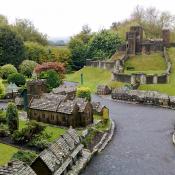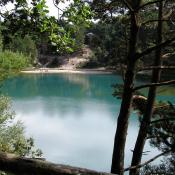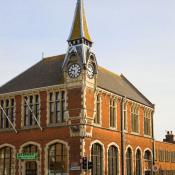Large 11th century castle that now lies in ruins since it was slighted in the English Civil War. It still cuts a majestic form dominating the village below
The village of Corfe Castle takes its name from the ancient fort that stands guard over a gap in the Purbeck hills. In ancient times the castle was of great strategic importance and even today the ruins are some of England's most majestic. The oldest surviving structure dates from the eleventh century, although evidence exists that there was some kind of stronghold here before the Norman Conquest, even, perhaps, dating back to Roman times.
The fort has a colourful history. It was here that Edward the Martyr was assasinated by his stepmother in 978, so that her own son, Ethelred the Unready, could inherit the throne. By the thirteenth century Corfe Castle was being used to store royal treasure and hold important prisoners. In 1210 Maud de Braose and her eldest son, William, were walled alive inside the dungeon, where they starved to death. Also imprisoned by King John in Corfe Castle was Eleanor of Brittany, elder sister of the murdered Prince Arthur and rightful heiress to England.
The castle remained a royal fortress until Elizabeth I sold it to Sir Christopher Hatton, her lord chancellor, in the sixteenth century. It changed hands several times before the civil war, when it was badly damaged in spite of valiant attempts by Lady Bankes and her supporters to withstand a six-week siege. After the restoration Corfe Castle was given back to the Bankes family, but it was so badly damaged they opted to build a new house on their other estate near Wimborne Minster rather than repair it.
Over the centuries that followed local householders completed what the civil war had begun, removing parts of the castle for use in their own homes. Materials and masonry from the castle can still be seen in houses all over the village. In the 1980s Ralph Bankes gave the whole Bankes estate to the National Trust, including Corfe Castle, a grade one listed building. During essential restoration work more evidence of the castle's importance was found in the form of an 'appearance door', designed for Henry I, which suggests that Corfe Castle was once one of the most important royal strongholds in the whole of England.
When the National Trust opened the castle to visitors it quickly became one of their most popular destinations, receiving nearly two hundred thousand visitors in 2009. There is parking just outside the village and a pleasant ten minute walk from here around the base of the mound to the entrance of the castle. Further waymarked walks explore the fallen walls and secret hideaways of the ruins, which are great for children although care should be taken around the steep, uneven slopes and sudden drops. There are dramatic views from the top.
The castle is open all year round, with special events in school holidays and occasional open-air theatre and cinema nights. There is a National Trust teashop at the castle entrance .




